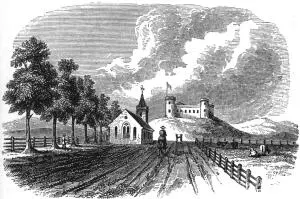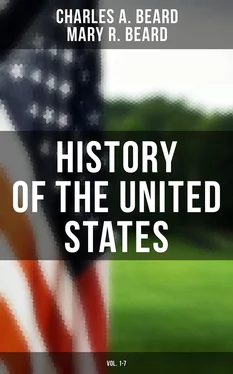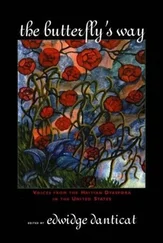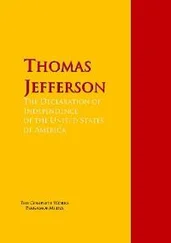| "O, willing hands to toil; Strong natures tuned to the harvest-song and bound to the kindly soil; Bold pioneers for the wilderness, defenders in the field." |
The Germans.—Third among the colonists in order of numerical importance were the Germans. From the very beginning, they appeared in colonial records. A number of the artisans and carpenters in the first Jamestown colony were of German descent. Peter Minuit, the famous governor of New Motherland, was a German from Wesel on the Rhine, and Jacob Leisler, leader of a popular uprising against the provincial administration of New York, was a German from Frankfort-on-Main. The wholesale migration of Germans began with the founding of Pennsylvania. Penn was diligent in searching for thrifty farmers to cultivate his lands and he made a special effort to attract peasants from the Rhine country. A great association, known as the Frankfort Company, bought more than twenty thousand acres from him and in 1684 established a center at Germantown for the distribution of German immigrants. In old New York, Rhinebeck-on-the-Hudson became a similar center for distribution. All the way from Maine to Georgia inducements were offered to the German farmers and in nearly every colony were to be found, in time, German settlements. In fact the migration became so large that German princes were frightened at the loss of so many subjects and England was alarmed by the influx of foreigners into her overseas dominions. Yet nothing could stop the movement. By the end of the colonial period, the number of Germans had risen to more than two hundred thousand.
The majority of them were Protestants from the Rhine region, and South Germany. Wars, religious controversies, oppression, and poverty drove them forth to America. Though most of them were farmers, there were also among them skilled artisans who contributed to the rapid growth of industries in Pennsylvania. Their iron, glass, paper, and woolen mills, dotted here and there among the thickly settled regions, added to the wealth and independence of the province.

From an old print
A Glimpse of Old Germantown
Unlike the Scotch-Irish, the Germans did not speak the language of the original colonists or mingle freely with them. They kept to themselves, built their own schools, founded their own newspapers, and published their own books. Their clannish habits often irritated their neighbors and led to occasional agitations against "foreigners." However, no serious collisions seem to have occurred; and in the days of the Revolution, German soldiers from Pennsylvania fought in the patriot armies side by side with soldiers from the English and Scotch-Irish sections.
Other Nationalities.—Though the English, the Scotch-Irish, and the Germans made up the bulk of the colonial population, there were other racial strains as well, varying in numerical importance but contributing their share to colonial life.
From France came the Huguenots fleeing from the decree of the king which inflicted terrible penalties upon Protestants.
From "Old Ireland" came thousands of native Irish, Celtic in race and Catholic in religion. Like their Scotch-Irish neighbors to the north, they revered neither the government nor the church of England imposed upon them by the sword. How many came we do not know, but shipping records of the colonial period show that boatload after boatload left the southern and eastern shores of Ireland for the New World. Undoubtedly thousands of their passengers were Irish of the native stock. This surmise is well sustained by the constant appearance of Celtic names in the records of various colonies.

From an old print Old Dutch Fort and English Church Near Albany
The Jews, then as ever engaged in their age-long battle for religious and economic toleration, found in the American colonies, not complete liberty, but certainly more freedom than they enjoyed in England, France, Spain, or Portugal. The English law did not actually recognize their right to live in any of the dominions, but owing to the easy-going habits of the Americans they were allowed to filter into the seaboard towns. The treatment they received there varied. On one occasion the mayor and council of New York forbade them to sell by retail and on another prohibited the exercise of their religious worship. Newport, Philadelphia, and Charleston were more hospitable, and there large Jewish colonies, consisting principally of merchants and their families, flourished in spite of nominal prohibitions of the law.
Though the small Swedish colony in Delaware was quickly submerged beneath the tide of English migration, the Dutch in New York continued to hold their own for more than a hundred years after the English conquest in 1664. At the end of the colonial period over one-half of the 170,000 inhabitants of the province were descendants of the original Dutch—still distinct enough to give a decided cast to the life and manners of New York. Many of them clung as tenaciously to their mother tongue as they did to their capacious farmhouses or their Dutch ovens; but they were slowly losing their identity as the English pressed in beside them to farm and trade.
The melting pot had begun its historic mission.
The Process of Colonization
Considered from one side, colonization, whatever the motives of the emigrants, was an economic matter. It involved the use of capital to pay for their passage, to sustain them on the voyage, and to start them on the way of production. Under this stern economic necessity, Puritans, Scotch-Irish, Germans, and all were alike laid.
Immigrants Who Paid Their Own Way.—Many of the immigrants to America in colonial days were capitalists themselves, in a small or a large way, and paid their own passage. What proportion of the colonists were able to finance their voyage across the sea is a matter of pure conjecture. Undoubtedly a very considerable number could do so, for we can trace the family fortunes of many early settlers. Henry Cabot Lodge is authority for the statement that "the settlers of New England were drawn from the country gentlemen, small farmers, and yeomanry of the mother country.... Many of the emigrants were men of wealth, as the old lists show, and all of them, with few exceptions, were men of property and good standing. They did not belong to the classes from which emigration is usually supplied, for they all had a stake in the country they left behind." Though it would be interesting to know how accurate this statement is or how applicable to the other colonies, no study has as yet been made to gratify that interest. For the present it is an unsolved problem just how many of the colonists were able to bear the cost of their own transfer to the New World.
Indentured Servants.—That at least tens of thousands of immigrants were unable to pay for their passage is established beyond the shadow of a doubt by the shipping records that have come down to us. The great barrier in the way of the poor who wanted to go to America was the cost of the sea voyage. To overcome this difficulty a plan was worked out whereby shipowners and other persons of means furnished the passage money to immigrants in return for their promise, or bond, to work for a term of years to repay the sum advanced. This system was called indentured servitude.
It is probable that the number of bond servants exceeded the original twenty thousand Puritans, the yeomen, the Virginia gentlemen, and the Huguenots combined. All the way down the coast from Massachusetts to Georgia were to be found in the fields, kitchens, and workshops, men, women, and children serving out terms of bondage generally ranging from five to seven years. In the proprietary colonies the proportion of bond servants was very high. The Baltimores, Penns, Carterets, and other promoters anxiously sought for workers of every nationality to till their fields, for land without labor was worth no more than land in the moon. Hence the gates of the proprietary colonies were flung wide open. Every inducement was offered to immigrants in the form of cheap land, and special efforts were made to increase the population by importing servants. In Pennsylvania, it was not uncommon to find a master with fifty bond servants on his estate. It has been estimated that two-thirds of all the immigrants into Pennsylvania between the opening of the eighteenth century and the outbreak of the Revolution were in bondage. In the other Middle colonies the number was doubtless not so large; but it formed a considerable part of the population.
Читать дальше














